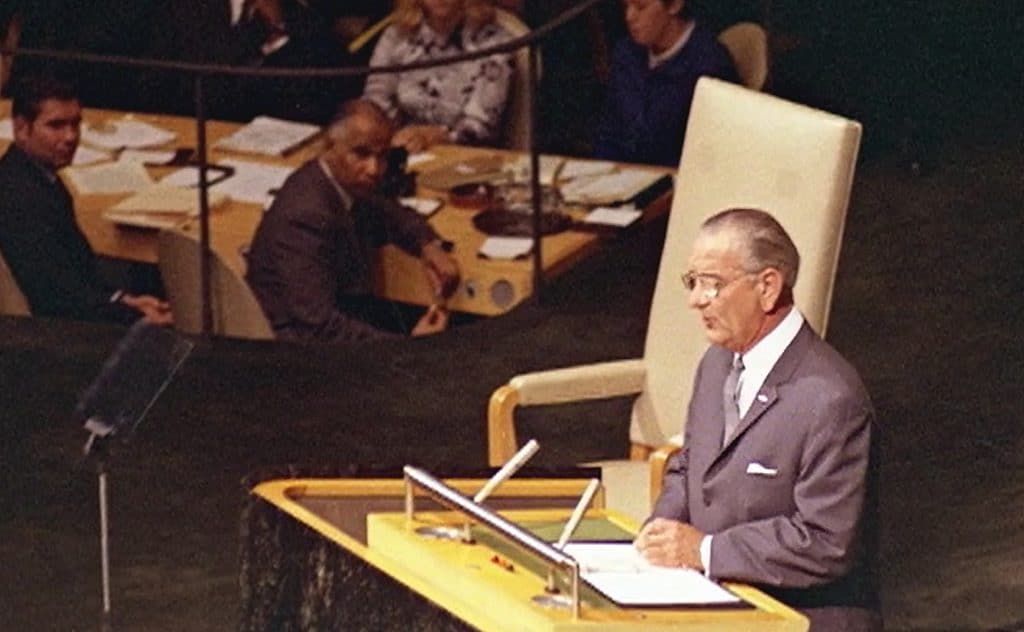The NPT took effect 50 years ago; its purpose has been debated from the beginning
By Jonathan R. Hunt | March 5, 2020
 US President Lyndon Johnson addresses the UN General Assembly during the signing of the Nuclear Non-Proliferation Treaty, 1968. Eventually, 188 countries signed the treaty, which was made into law in 1970. Photo credit: Screen capture from the documentary Good Thinking, Those Who've Tried To Halt Nuclear Weapons.
US President Lyndon Johnson addresses the UN General Assembly during the signing of the Nuclear Non-Proliferation Treaty, 1968. Eventually, 188 countries signed the treaty, which was made into law in 1970. Photo credit: Screen capture from the documentary Good Thinking, Those Who've Tried To Halt Nuclear Weapons.
The Treaty on the Non-Proliferation of Nuclear Weapons (NPT) took effect (or, in diplomats’ parlance, “entered into force”) 50 years ago, on Thursday, March 5, 1970.
The milestone global agreement is beginning to show its age.
Hailed in 2003 by US Ambassador Thomas Graham Jr. as “the centerpiece of international efforts to control the spread of nuclear weapons”—a common refrain among treaty supporters around the world—the NPT has weathered a line of storms since the turn of the millennium: the termination of the 1972 Anti-Ballistic Missile Treaty, the 2003 Iraq War, North Korea’s nuclear-weapons program, the dismantlement of the nuclear agreement between Iran and major world powers, a long-heralded nuclear renaissance with implications for global fissile-material production, the demise of the 1987 Intermediate-range Nuclear Forces Treaty, parallel modernization efforts by the nuclear powers, President Donald Trump’s unabashed nationalism, and the rival Treaty for the Prohibition of Nuclear Weapons’ that opened for signature nine years ago.
Against these headwinds, the states that are party to the NPT will meet from April 27 to May 22, 2020, at the NPT Review Conference at UN Headquarters in New York, which happens regularly at five-year intervals. Amid deep, enduring divisions over matters ranging from a WMD-free zone in the Middle East to moribund New START talks between Washington and Moscow (which the Trump administration wants to expand to include all five authorized nuclear-weapon states), it remains unclear as to whether conference delegates will succeed in forging a consensus document—and what will happen if they fail.
The rights, duties, and expectations that the international community imprinted on the NPT from the first proposal of a “nuclear restriction” on September 19, 1958, to the treaty’s opening for signature on July 1, 1968, will be subject to considerable debate at the Review Conference. This is because no two states share the same interests. But it is also because states subscribe to clashing interpretations of the treaty’s history, whether the formative intents of its many drafters, or the original meanings they inscribed in its preamble and eleven articles.
This divergence of interpretations was visible as early as April 26, 1968, when 124 delegations convened at the 22nd Session of the United Nations General Assembly to confer about a draft nuclear nonproliferation treaty. That day, US Ambassador Arthur Goldberg and his Soviet counterpart, Vasili Kuznetsov, characterized it in starkly different terms. Goldberg, who had resigned from the US Supreme Court to replace Adlai Stevenson as President Lyndon Johnson’s man at the United Nations, toasted the draft treaty as “the creation of all nations, large and small” that served on the Eighteen Nation Committee on Disarmament in Geneva. This exemplary feat of multilateral conference diplomacy had yielded a prospective compact that reflected, in Goldberg’s eyes, “three major purposes”: to lessen the odds of nuclear weapons falling into new hands, to build a global regime that the International Atomic Energy Agency would lead to promote fair and equitable access “to the peaceful blessings of nuclear energy,” and to internationalize the pursuit of nuclear as well as general and complete disarmament.
Kuznetsov, by contrast, highlighted “the uppermost and in our opinion predominant feature of the draft”: to close “all channels, both direct and indirect, leading to the possession of mass destruction weapons.” This emphasis on what might be styled “nonproliferation first” attested to the Kremlin’s preoccupation with West Germany—the arrival of the ultimate weapon in the hands of those who had twice launched devastating wars against the Russian people that century was intolerable. (That the former Axis power remained in a technical state of war with members of the Warsaw Pact was a signal consideration as well.)
This schism between the NPT’s “grand bargain” of three elements and the predominance of regulating dual-use nuclear technology still defines treaty discourse 50-plus years later. Only, now, instead of pitting one superpower against the other, the United States and Russia both place overriding emphasis on the non-acquisition of nuclear weaponry by the vast majority of treaty’s signatories—while, for their part, the nuclear unarmed emphasize what many dub the NPT’s “three pillars.” The schism was visible, for example, when current US Assistant Secretary of State for International Security and Nonproliferation Christopher Ford’s asserted in 2007 that the treaty obligated “all states party” “to pursue negotiations in good faith” on nuclear arms control and also disarmament. And it is belied by what has proven the most insuperable obstacle to Review Conference consensus: the creation of a WMD-free zone in the Middle East.
International treaties are strange creatures. Each is the product of tortuous negotiations, often in the aftermath of major historical conjunctures—horrific wars, terrible famines, viral epidemics, religious strife, continental congresses, global decolonization. Each replaces or reforms the operating system that helps nations, states, and peoples to coexist within mutually agreed (or at least mutually recognized) frameworks of laws, norms, and institutions. Each is ultimately a victim of capricious circumstances. Each carries the seeds of its own destruction within. And each is often taken for granted until it’s gone.
The NPT belongs to the subset of international agreements that reformed an existing order, in this case the post-1945 international community that the United Nations Charter constituted. It happened at a moment when the international community was in the throes of decolonization in Latin America, Africa, Asia, and the Middle East, and those European and East Asian nations that had been laid to waste during the Second World War were experiencing industrial renaissances at the relative expense of US industrial preeminence. While Soviet and American negotiators spent years working out the NPT’s non-dissemination and non-acquisition language, with their implications for NATO nuclear-sharing, the remainder of the treaty’s articles took form in the back-and-forth between the superpowers and other states belonging to multiple groups: Afro-Asian nations, non-aligned powers, neutral states, advanced economies eyeing global markets, countries with large uranium mines, Latin American republics concurrently negotiating a nuclear-weapon-free zone, and regional powers like India, West Germany, Israel, Brazil, and Japan with latent nuclear-weapon capabilities.
Against this postcolonial background of accelerating globalization, a Cold War odd couple—the United States and the Soviet Union (and since 1991 the Russian Federation)—forged a working relationship that became the heart of the treaty’s success. It was remarkably unlikely. The US-Soviet nonproliferation partnership achieved exit velocity at what appeared to be a low point in their relations: the Americanization of the Vietnam War in 1965.
Why did Moscow and Washington make common cause? There’s more than one answer.
President Johnson appears to have found the issue irresistible as a way to burnish his peacemaking credentials as his ramped-up military efforts in Southeast Asia incited domestic backlash. Soviet Secretary Leonid Brezhnev believed it would isolate the People’s Republic of China and open a way to formalize Soviet gains in Europe by expediting a long-delayed continental peace treaty. Yet the negotiating record in the Eighteen Nation Disarmament Committee and the United Nations First Committee—the two venues where the treaty was mainly drafted—reveal a deeper impulse: a belief that the ideological foes needed to restrain their competition lest allies and neutrals alike take them for a ride.
A meeting between the principal American architect of the NPT, US Arms Control and Disarmament Agency director William Foster, and his Soviet counterpart, Semyon Tsarapkin, was exemplary. On February 11, 1964, the two sat down to discuss why a non-diffusion treaty would advance their mutual interests. As Tsarapkin put it, “all other countries including France, China, India, [the United Arab Republic], . . . even [the German Democratic Republic], were playing [the] US and USSR against each other and were trying to obtain advantage from differences and contradictions between them; they could do it in present circumstances but if [the] US and USSR were to agree with each other everybody else would have no choice but to fall in line.” When the Eighteen Nation Disarmament Committee finalized a draft treaty four years later, delegates from the Eastern, Western, and nonaligned blocs would joke that “the only thing” the American and Soviet contingents “didn’t do was hold hands.”
When US Ambassador Goldberg introduced the consensus draft treaty in New York on April 26, 1968, he contended that the periodic review conferences would play a central role in maintaining the balance between nonproliferation, peaceful uses, and arms control. His country, he affirmed, “believes that the permanent viability of this treaty will depend in large measure on our success in the further negotiations contemplated by Article VI”—the part of the treaty dealing with nuclear and general disarmament. To make good on Goldberg’s promise that the United States would undertake “further disarmament negotiations with redoubled zeal and hope and with promptness,” once the treaty opened for signature in London, Moscow, and Washington DC on July 1, 1968, President Johnson and Soviet Premier Alexei Kosygin simultaneously announced their intent to launch strategic arms limitation and anti-ballistic missile talks “in the nearest future.”
More than a half-century later, the NPT counts 188 countries among its member states. The 1972 Anti-Ballistic Missile Treaty no longer exists as a restraint on global nuclear competition, while the 1972 SALT Treaty was superseded by the START Treaty in 1991, and then the New START Treaty in 2011, which itself may be at risk of collapsing in 2021. Even though the NPT’s indefinite extension in 1995 has lessened the stakes in the Review Conference process, the quinquennial gathering is still that rare opportunity to take the temperature of the treaty as well as the global regime of which it remains the centerpiece.
As nuclear weapon states and non-nuclear-weapon states eye the next half-century of the nuclear nonproliferation regime, they might contemplate the words of Reinhold Niebuhr, whom Foster quoted when he was asked to explain his mission just as nonproliferation talks were taking off in 1964: “The task of creating community and avoiding anarchy is constantly pitched on broader and broader levels,” the American theologian and philosopher had remarked. “That continues to be true,” Foster added, “to an ever-increasing degree.” As the NPT enters its sixth decade, this maxim has lost none of its power.
The author wishes to acknowledge the Carnegie Corporation of New York for its funding and support for a two-year research consortium whose members will generate, disseminate, and preserve historical knowledge about the NPT’s constitutional history.
Together, we make the world safer.
The Bulletin elevates expert voices above the noise. But as an independent nonprofit organization, our operations depend on the support of readers like you. Help us continue to deliver quality journalism that holds leaders accountable. Your support of our work at any level is important. In return, we promise our coverage will be understandable, influential, vigilant, solution-oriented, and fair-minded. Together we can make a difference.
Keywords: NPT, NPT Review Conference, Nuclear Nonproliferation Treaty, UN General Assembly, nonproliferation
Topics: Nuclear Weapons














